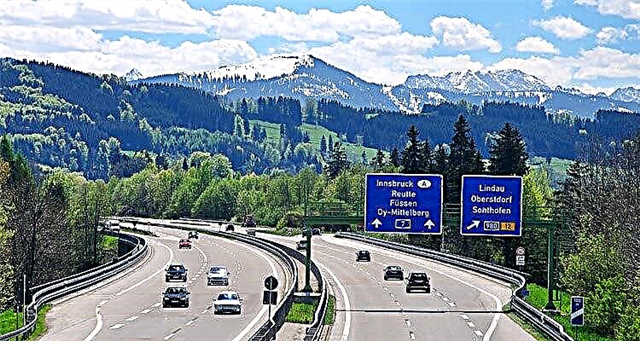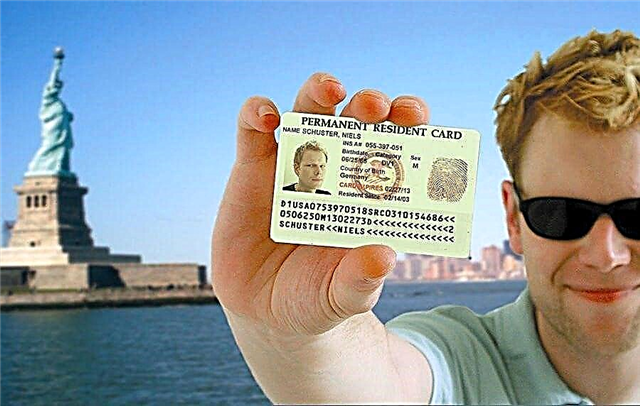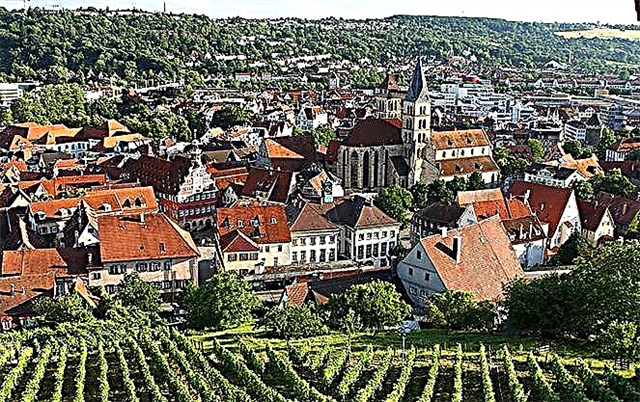Tourists and visitors to the city of Stuttgart are invariably attracted by the temples famous even outside Germany. Many of them bear the imprint of past centuries, others were rebuilt relatively recently, and still others have successfully survived several reconstructions. Temples, cathedrals and mosques in Stuttgart are religious buildings, they attract attention with unusual architectural ensembles, compositions and stained glass windows, entertaining stories, interior decoration and famous names.

The oldest monastery church in the city
At the foot of the Florentine Mountain, in the Marktplatz shopping area, is the famous Monastery Church.
It is the only structure that has survived from the time of the Hohenstaufen dynasty - the South German kings of the Holy Roman Empire, who ruled from 1138 to 1254.
Locals call the building "Stiftskirche" and do not get tired of repeating that this particular church is officially recognized as the most ancient building in the city.
It is difficult to determine the exact years of the foundation of the Monastic Church; historians agree that the building was completed no later than the 11th century.
For several centuries it was used advantage as a burial vault for the Dukes of Württemberg. Now the main Protestant temple in the city is decorated with statues of eleven rulers of the aforementioned family, the composition is located in the choir. She was not touched during several large-scale rebuildings. However, construction and restoration work still influenced the appearance of the church.
Initially, the building was made in the Romanesque style, in the 16th century Gothic features were added to the exterior, and in the 17th century the influence of the Baroque became noticeable.
The building was last renovated in 1867. Since then, only minor cosmetic changes have been made. The exterior looks asymmetrical, exhilarating in a Gothic style, and includes two towers. The western one has eight corners, while the southern one has only four and a sharp roof.

In the basement floor of the south tower, fragments of construction are still preserved, which historians date back to the century. The portals are impressively decorated, and the facades are attractive with original finishes. Their architects tried to leave them in their original form, when the Stiftskirche was still serving as a Romanesque basilica, the first parish church in Baden-Baden.
The interior decoration of the Monastery Church is amazing - here you can find a crucifix with a height of 6 meters, it was made in 1467 by Nikolaus Gerhart von Leiden.
Nearby are the tombstones of the margraves, among which is the monument to Louis Turetsky, who became famous for his victory over the Turks.
It is impossible not to mention the legendary organ, the mighty sound of which the guests of the church can enjoy to this day. The musical instrument was mentioned in written sources in 1558, after a century and a half it survived a serious fire and was restored.
The temple is located at Stiftstraße 12, 70173. The most convenient way to get to Stiftskirche is by metro, getting off at the Schlossplatz station. The church is open to visitors every day from eight to eighteen, admission is free.
A visit to the Monastery Church is included in almost every walking tour of the city; the building is located in the historic district of Stuttgart, next to the Thermal Ruins, the Faberge Museum and the New Castle.
Church of St. Leonhard
The Leonhardskirche ranks second in the ranking of the oldest churches in Stuttgart. It is located in the historic center of the city, at Leonhardsplatz 10/1, 70182. It serves as the center of the Protestant church community.
The original building was erected in 1337 on an open field next to the Esslinger Tor gate. At that time, the chapel in honor of St. Leonhard began to function. The first global restructuring overtook the building until 1408. The chapel was replaced by a one-nave church with a choir and a tower.
After 50 years, the city authorities again returned to the expansion, for this purpose they hired the architect Aberlin Jorg. He oversaw the construction, during which the building became a three-nave church with an elongated choir and a side tower.

Leonhardskirche acquired the recognizable features of the Gothic architectural style. Its importance for the city continued to grow, but until 1806 the church remained under the jurisdiction of the Monastery Church.
She managed to survive in its original form until 1944. During the devastating bombing of Stuttgart, the church was badly damaged. It was restored in 1948-1954; the restoration work was supervised by Rudolf Lemp.
A notable addition to the church's modern appearance is the large organ, built in 1970. It includes as many as 58 registers, three keyboards and a pedal - mechanical gaming tracts.
Anyone can hire a guide to get to know the temple in more detail. Tourists can find more detailed information on the official website - leonhardskirche.de.
Erloserkirche
Erlöserkirche or Church of the Redeemer, located at Birkenwald Strasse 24. It has an evangelical direction and has been operating since 1906. It was designed by Theodor Fischer, the most respected architect in southern Germany at the time.
Unfortunately, the temple could not survive the bombing of 1944; during an air raid it was almost destroyed to the ground. Reconstruction began in 1950 under the direction of Rudolf Lemp and ended in 1954.

The first project of the temple was notable for its color dullness: it was planned to make the building harmonious, the shades for the walls and roof were chosen based on the surrounding landscape. They decided to build the foundation from tuff, partly because of the suitable color (it is a processed rock), and partly for reasons of economy.
The roof was covered with discreet red tiles, and the spire was made green. Numerous artists and sculptors have worked on the interior decoration, among them Emil Kimlen and Oscar Pfennig.
Evangelical Castle Church
The medieval church, built in the 15th century, looks like a castle. It is characterized by the Romanesque style, the basic elements of the early Gothic and the brighter details of the late Gothic direction. Stretched up, with small windows and a minimum of decoration - many travelers call the Evangelische Schlosskirche austere.
It is open to the public every day from 10.00 to 17.00 (Monday to Saturday inclusive) at Schillerplatz 6, 70173.
Hospital church
The Hospital Church is the third largest medieval church in the city. The date of its construction is considered to be 1490. The project was developed and implemented by the famous Württemberg architect Aberlin Jörg especially for the Dominican Order (a Catholic monastic order founded by a Spanish monk named Dominic).
Initially, the Hospital Church was a three-nave basilica. The tower, which can be seen today, was completed later, presumably in the 1730s.
The temple, built for the Dominicans, managed to survive the order, but during the Reformation it temporarily ceased activity. It was decided to convert it into a hospital, which is why in the 17th century, when the building regained its cult status, they began to call it the Hospital Church.
But the changes for the Hospital Church did not end there either: a second re-equipment was waiting for it, the Nazis decided to arrange a prison here. It is known that communists, gypsies and Jews were kept inside - all those who were hunted by Hitler's regime.
This state of affairs remained relevant until the partial destruction of the building during the bombing of the city. The church was rebuilt and reconstructed by 1960. The dilapidated altar of 1489 was restored to its original form, as well as several tombstones.
Another feature of the interior is the original crucifix, created in 1501 by the sculptor Hans Seifer.
Everyone can visit the church with an amazing history; it is located at 22-24 Hospitalstraße.
Faith Chapel
Connoisseurs of the Gothic style call Veitskapelle a precious gem. The chapel got its name in honor of Saint Faith, who lived in the 3rd century. It is known that he remained faithful to his religious beliefs even under the threat of torture.
Externally, the building looks restrained, but inside you can see murals on which the artists depicted not only scenes from the life of Faith, but also well-known biblical motives.
It is noteworthy that the chapel has remained intact to this day. Divine services continue every Sunday, starting at 9.30 am local time.
To coordinate visits, the administration provided the telephone number +49 (711) / 53 23 13. The chapel is officially open for tourists from May to the end of September on Sundays from about 14.00 to 16.30.
The Veith Evangelical Chapel is located in Mühlhausen, Meierberg 16, 70378 Stuttgart-Muhlhausen.
Church of St. Nicholas
The project of the Church of St. Nicholas the Wonderworker was approved in 1894; it was decided to build it on the square overlooking the Hegelstrasse. The city government of Stuttgart sold the site for twelve thousand marks, Russia allocated 75 thousand rubles for the project itself.
The initiators of the construction did not hesitate to lay the first stone: the ceremony took place in 1895, and Ludwig Eisenlor was appointed chief architect. In December of the same year, the temple was consecrated, and many church items were brought here, which had previously been kept in the villa of Nicholas I's granddaughter, Vera Konstantinovna, Duchess of Württemberg.

During the First World War, the church did not work. In 1938, it was transferred to the Diocese of Orthodox Bishops of Berlin and Germany to the ROC abroad.
Outwardly, it has the shape of a triangle, an altar stands out on the east side, and a porch and a bell tower on the south. The walls of the building are made of sandstone, the upper floors are made of red bricks. The temple can hold up to 250 people.
Public transport goes to the Church of St. Nicholas. Bus number 40 goes to the Hegel- / Seidenstraße stop, tram number 2 to the Russische Kirche stop.
Up-to-date information on the activities of the temple can be found on the website translated into Russian.
Conclusion
The oldest building in Stuttgart was the church. We recommend starting your acquaintance with the city from the majestic Monastery (palace) church. A visit to the Church of St. Nicholas, a kind of museum of the history of Christianity of the Eastern rite in Germany, will become a landmark for Orthodox tourists. The past of the Hospital Church can also be called interesting and exciting.
Most of the churches, mosques and cathedrals of the city are ancient, with a long history behind them. The objects are annually visited by tourists, believers and people keen on architecture.











